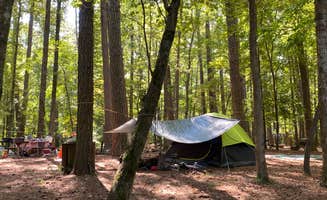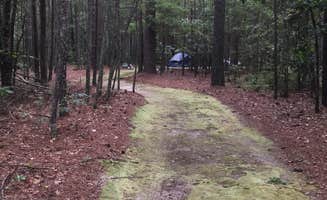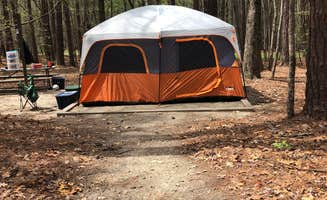Tent camping near Spring Lake, North Carolina offers primitive to moderate accommodations within a 30-mile radius. The region features sandy soil conditions typical of the Sandhills ecosystem, with pine forests dominating the landscape. Summer temperatures regularly exceed 90°F between June and September, making spring and fall the most comfortable camping seasons.
What to do
River activities: At Lumber River State Park's Chalk Banks, campers can enjoy fishing and paddling on the Lumber River. "Easy parking nice boat ramp for the kayaks," notes camper Danny R., who visited during Memorial Day weekend. The park features a dedicated water access point about half a mile from the campground.
Hiking trails: San-Lee Park in Sanford provides multiple hiking trails connecting the camping area to the park's lake and facilities. A camper reports, "There are hiking and biking trails as well as kayaking and other water sports on the lake there." The trails accommodate various skill levels and connect to the nature center and paddle boat rental area.
Wildlife observation: William B. Umstead State Park offers designated nature trails where campers can observe local wildlife in a preserved forest setting. Despite its proximity to Raleigh, the park maintains substantial woodland habitat. "It seems to be an outdoor oasis as you can get lost in the woods with the hustle and bustle of the city all around you," states one visitor.
What campers like
Privacy levels: The tent sites at Chalk Banks offer exceptional spacing and seclusion. "These campsites are in a beautiful pine woods forest. Many sites have a pretty mossy pathway near the tent platform," reports Joe L. Another camper, S.H. S., confirms, "The tent sites are some of the better spread out ones that I've seen."
Gate security: Most campgrounds in the region implement after-hours security measures. At Chalk Banks, campers receive gate codes for after-hours access. One visitor notes, "The ranger that greeted us was super nice and respectful. He gave us the gate code in case we needed to leave after they closed the gate at 9:00pm."
Foraging opportunities: Several camping areas permit collection of fallen wood for campfires. According to Cody T., who stayed at Lumber River State Park, "There is a lot of wood to gather for your fire but if you want to buy firewood then you'll have to drive to the speedway about 10 minutes down the road."
What you should know
Limited facilities: Most tent campgrounds near Spring Lake offer basic amenities only. At San-Lee Park, "The sites have fire pits, grills, tables, and there are a couple of water spigots on the site. There are also bathrooms with showers." Expect similar basic setups at most locations, with varying levels of water access.
Reservation systems: Campgrounds operate under different reservation policies. San-Lee Park requires advance planning, as one camper discovered: "We were told you can only camp there by making reservations 72 hours ahead of time." Always call ahead to confirm current procedures.
Weather considerations: Summer camping requires heat preparation. Bruce H. advises about Chalk Banks: "Sites are primitive but well cared for... bring mosquito repellent." The humid climate makes insect protection essential from April through October.
Access roads: Some camping areas require appropriate vehicles. For Sandhills Campground B, campers need "4 wheel drive or a vehicle with good clearance, as it's all dirt roads in and around and leading to here."
Tips for camping with families
Playground access: William B. Umstead State Park Campground provides family-friendly camping with nearby recreational facilities. "There are pavilions that are great for cooking or serving a large brunch," notes Sarah M., making it suitable for family gatherings with children.
Cabin alternatives: Families seeking more structure can utilize cabin options. At Umstead State Park, "there are historic cabins with cots to sleep on" and "there is electricity in the cabins," according to Erica F., providing an alternative to tent camping for families with young children.
Site selection: At San-Lee Park, sites work well for family groups staying together. One camper describes it as "an okay place, great if you are with a large group, as the sites are open but situated somewhat close to each other." This configuration allows families to book adjacent sites while maintaining sight lines between them.
Tips from RVers
Limited hookup availability: RV campers have restricted options near Spring Lake. Chalk Banks offers a designated RV area with pull-through sites. According to Marvin D., "The right hand side of the campground is set up for RVs (pull through sites)." However, most campgrounds in the region primarily accommodate tent camping.
No dump stations: RVers should arrive with empty holding tanks and prepare to leave without dumping. None of the campgrounds within 30 miles of Spring Lake offer sanitary dump stations, requiring self-contained operation or planning stops at commercial facilities along major highways.




